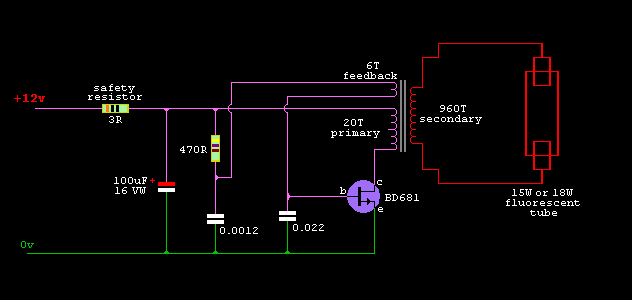
This fluorescent light inverter uses just one transistor & a transformer wound on a ferrite rod. The clever component is the transformer, it performs 3 functions. Firstly, it acts as a feedback component for the transistor to create an oscillator circuit. Secondly, it provides a high voltage (over 2kV) to strike the fluorescent tube & thirdly it supplies energy to keep the tube illuminated.
The transformer has 3 windings. The 20 turn primary is switched by the BD681 & the resulting primary voltage of around 24V peak to peak (plus considerable spikes) is stepped up in the 960 turn secondary. Positive feedback is applied from the third winding to the base of the BD681 to ensure that the circuit oscillates continuously.
The ferrite core of the transformer is an antenna rod from a transistor radio. You can use a slab antenna but I chose to use an antenna rod 6cm long & 9mm in diameter.
The primary winding is the first to be wound, on 45mm of the rod, using 20 turns of 0.5mm diameter enamelled copper wire. Use grease-proof paper as the interlayer insulation. The second winding is the feedback winding & consists of 6 turns of 0.3mm wire wound in a spiral fashion so that it lies over the full length of the primary winding.
The secondary winding consists of 960 turns of the 0.3mm wire. The feedback winding must be connected the right way around so that the BD681 gets positive feedback. When first powered up, connect the 3Ω safety resistor in the positive line & connect the feedback winding. Then turn the circuit on & off very quickly & if the fluorescent tube does not come on immediately, the feedback winding is the wrong way around. The safety resistor allows a limited current to flow through the circuit & the BD681 will not be damaged.
Once the correct feedback connection has been established & the fluorescent light comes on correctly, remove the 3Ω resistor & the circuit is ready to use. However, you must not use the circuit without the fluorescent tube connected because it provides loading for the transformer & has a damping effect on the spike voltages to the transistor's collector each time it switches off.
By J Draper, Glenview, Queensland Australia.